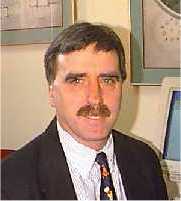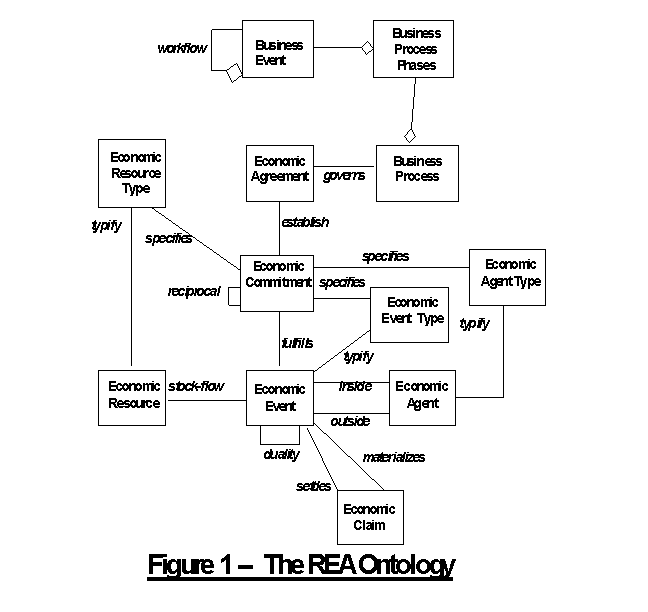Ontolog invited Speaker Presentation - Professor William E. McCarthy - Thu 2005-03-17 (5KH)
Conference Call Details (5KI)
- Subject: [ontolog] Invited Speaker Presentation - BillMcCarthy - Thu 2005-03-17 (5KJ)
- Agenda: Professor William E. McCarthy will be giving a talk entitled: "The Integration of an Accounting Domain Ontology (REA) with an Upper Ontology (SUMO)" (5KK)
- Date: Thursday, Mar. 17, 2005 (5KL)
- Start Time: 10:30 AM Pacific Standard Time / 1:30 PM Eastern Standard Time (see world clock for other time zones) (5KM)
- Duration: 1.5~2 hours (5KN)
- Dial-in Number: 1-702-851-3330 (Las Vegas, Nevada) (5KO)
- Participant Access Code: "686564#" (5KP)
- Shared-screen support (VNC session) will be started 5 minutes before the call at: http://vnc2.cim3.net:5800/ (5KQ)
- view-only password: "ontolog" (5KR)
- if you plan to be logging into this shared-screen option (which the speaker may be navigating), and you are not familiar with the process, please try to call in 5 minutes before the start of the session so that we can work out the connection logistics. Help on this will generally not be available once the presentation starts. (5KS)
- people behind corporate firewalls may have difficulty accessing this. If that is the case, please download the slides below and runing them locally. The speaker will prompt you to advance the slides during the talk. (5KT)
- RSVP to peter.yim@cim3.com appreciated, to allow us to prepare enough conferencing resources. (5KU)
- Information relating to this session is shared on this wiki page: http://ontolog.cim3.net/cgi-bin/wiki.pl?ConferenceCall_2005_03_17 (5KV)
- For Virtual Speaker Session Tips and Ground Rules - see: VirtualSpeakerSessionTips (5KW)
Attendees (5KX)
The editing to the wiki has been temporarily disabled due to heavy spam attack; kindly RSVP by e-mail as above. Thanks. -ppy (5KY)
- Attended: (5KZ)
- Expecting: (5LB)
- AnthonyCheung (5LC)
- MichaelHogarth (5LD)
- Todd Grimmett (Kevric) (5LE)
- Robert Coyne (TopQuadrant) (5LF)
- Regrets: (5LG)
- NicolasRouquette (on vacation) (5LH)
- DuaneNickull (in Kuala Lumpur) (5LI)
- JonathanCheyer (5LJ)
- KurtConrad (5LK)
- NancyFaget (5LL)
- JamesDouma (schedule conflict) (5LM)
Agenda & Proceedings (5LN)
- Professor William E. McCarthy from Michigan State University will be giving a talk entitled: "The Integration of an Accounting Domain Ontology (REA) with an Upper Ontology (SUMO)" (5LO)
 [Professor William E. McCarthy] (5LP)
[Professor William E. McCarthy] (5LP)
Abstract: (5LQ)
The REA (Resource-Event-Agent) enterprise ontology is a well-accepted model of the concepts and relationships that exist in a normal economic exchange between companies or conversions within companies. REA is based upon a foundation grounded in both accounting and economic theories of the firm, and it is used in the accounting domain extensively for both research and teaching in accounting systems. The seminal REA paper was published in The Accounting Review in 1982, and its basic framework has been extended multiple times in recent years in work by Geerts and McCarthy. The REA ontology has been used in standards work within the UN/CEFACT, ISO, and other standards bodies. A simple UML summary of REA is illustrated in Figure 1. (5LR)
 [Fig. 1 - The REA Ontology] (5LS)
[Fig. 1 - The REA Ontology] (5LS)
All domain ontologies need to reconciled eventually to an upper ontology if they expect to be used extensively across domains, and the interrelated domain concepts and associations need to be mapped to those of the upper ontology where those correspondences exist. The upper ontology to be used in this mapping exercise with REA is SUMO, the Suggested Upper Merged Ontology, one of the IEEE Standard Upper Ontology working group starter documents. SUMO is extensively used and researched in the computer science community, and its conceptual structures are better defined and integrated than those of more informal ontological frameworks like Bunge and Sowa. Sowas conceptual framework fits REA well, but Bunges is a clear conceptual mismatch. (5LT)
Mapping to more general ideas and axioms can be both a quality control and a concept expansion exercise. There are bound to be many gaps and overlaps, just as one would find in mapping individual external schemas to a more general conceptual schema in the database design process of view modeling and view integration. The integration exercise to be described in this presentation is most certainly preliminary, and it is being accomplished by an REA expert who is also an acknowledged SUMO novice. The domain concepts of REA work extremely well in the process modeling of inter-firm business collaborations and in the re-orientation of basic accounting ideas away from the artifactual grip of general ledgers and traditional accounting reporting. Their integration with SUMO will be another step on the path to assessing their suitability for use as a more general enterprise ontology. (5LU)
- Session Format: this will be virtual session over a phone conference setting, augmented by shared computer screen support (5LV)
- Bio of Professor William E. McCarthy: (5LZ)
William E. McCarthy is a Professor of Accounting and Information Systems at Michigan State University. He received his A.B. in economics from Boston College in 1968 and his Ph.D. in accounting and computer science from the University of Massachusetts in 1978. His homepage is available at http://www.msu.edu/user/mccarth4/ (5M0)
Professor McCarthys research interests center around the application of knowledge-based systems, object orientation, and database theories to the problems of building information architectures for use between and within business enterprises. His papers have been published in many leading accounting and computer science journals, and he has given invited presentations to a wide variety of academic and business institutions in the USA, Europe, Asia, and Australia. Professor McCarthys paper on REA accounting systems was given the first Seminal Contribution to Accounting Information Systems Literature Award at the American Accounting Association meeting in Chicago in 1996. His present research focuses on (1) the development of REA enterprise ontologies, (2) the integration of REA models within XML, and (3) the development of agent-oriented information systems with REA business process patterns. (5M1)
Most recently, he has been especially active in international e-commerce standardization efforts. He was a member of the business process team of the UN-based ebXML project, and he is also active with the UNs Technologies and Methods Workgroup and the ISO-based Open-edi initiative. He was also active in semantic integration and model-based standards development work with the Open Applications Group (OAG) and the Object Management Group (OMG). For the years 2001-2003, he was the Vice-President of the American Accounting Association (AAA), and every summer he teaches at MSU an AAA-sponsored workshop on REA accounting systems to accounting faculty from all over the world. (5M2)
Professor McCarthy teaches a wide variety of graduate and undergraduate information systems classes at MSU, and he was the recipient of the Department of Accountings Roland F. Salmonson Outstanding Teaching Award in 1985, in 1993, and again in 2003. He is also cited in the 1995, 1998, and 2001 versions of the Business Week Guide to the Best Business Schools as one of the outstanding graduate teachers in the Broad College of Business, and in 1999 he was given the outstanding faculty teaching award from the Spartan Business Journal (MBA student newspaper). In 1999, Professor McCarthy was given the Withrow Teacher-Scholar Award, the lifetime teaching award from the Broad College of Business, and in 2003 he was given the American Accounting Associations Innovation in Accounting Education Award. In February 2000, he was presented with the highest recognition given to professors at Michigan State University: the MSU Distinguished Faculty Award. (5M3)
- Professor McCarthy's presentation can be accessed by pointing your web browsers to: (5M4)
- http://ontolog.cim3.net/file/resource/presentation/BillMcCarthy_20050317/Integrating-REA-Ontology-with-SUMO--BillMcCarthy_20050317.ppt (5M5)
- links to additional relevant resources: (5M6)
- Working paper by Guido L. Geerts & William E. McCarthy: "The Ontological Foundations of REA Enterprise Information Systems" - March, 2005 (5M7)
- (please post any additional resources here) (5M8)
- Any material outside of the prepared presentation, if they are called up during the session, may be shared under the VNC session detailed above (5M9)
- If you have questions for the presenter, we appreciate your posting them here: (please identify yourself) (5MA)
- Session ended 12:32 pm PST (5MF)
Session Recording of the BillMcCarthy Talk (5MG)
(Thanks to BobSmith for their help with getting the session recorded. -ppy) (5MH)
- To download the audio recording of the presentation, click here (5MI)
- the playback of the audio files require the proper setup, and an MP3 compatible player on your computer. (5MJ)
- Conference Date and Time: Mar. 17, 2005 10:45~12:32 PM Pacific Std Time (5MK)
- Duration of Recording: 1 Hour 48.5 Minutes (5ML)
- Recording File Size: 38 MB (in mp3 format) (5MM)
- Telephone Playback Expiration Date: March 27, 2005 11:26 AM Pacific Std Time (5MN)
- Prior to the above Expiration Date, one can call-in and hear the telephone playback of the session. (5MO)
- Playback Dial-in Number: 1-805-620-4002 (Ventura, CA) (5MP)
- Playback Access Code: 592764# (5MQ)
- suggestion: best that you listen to the session while having the presentation opened in front of you. You'll be prompted to advance slides by the speaker. (5MR)